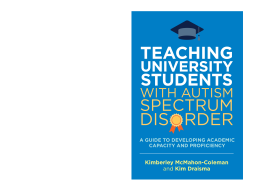
BOOK
Teaching University Students with Autism Spectrum Disorder
Kim Draisma | Kimberley McMahon-Coleman
(2016)
Additional Information
Book Details
Abstract
Based on the findings of a five year longitudinal study into the experiences of students with Autism Spectrum Disorder (ASD), this book provides tertiary educators and support staff with practical support for addressing the challenges associated with ASD as they manifest in college and university environments. It explores issues such as:
· Interpreting assignment tasks
· Unwritten expectations and codes of conduct
· Rigidity of thinking
· Project planning
· Self-monitoring
· Multi-tasking and central coherence
The authors suggest practical strategies for better accommodating students with ASD in the inclusive classroom. Chapters include case studies of individual students, which provide real world examples of possible issues and successful interventions, making this an essential resource for all those involved in supporting students with ASD in tertiary education settings.
Academic staff, students who have an Autism Spectrum Disorder, and their parents, need a comprehensive guide to successfully graduating from college or University. The explanations and recommendations in this book are based on extensive experience of supporting and explaining the thinking and needs of students who have an ASD, while understanding the perspectives of both staff and students. Academic success and graduation will now be much easier to achieve.
Tony Attwood, PhD, Clinical Psychologist, Minds & Hearts Clinic, Australia, and author of The Complete Guide to Asperger's Syndrome
In the increasingly busy world of the academic, this book is invaluable. It is a comprehensive yet practical, step-by-step guide to easily developing teaching knowledge and successful strategies for working with university students with ASD. Vibrant case studies, clear tools & quick tips for teachers abound.
Petria McGoldrick, Disability Liaison Officer, University of Wollongong, Australia
McMahon-Coleman and Draisma have provided the higher education sector with a much-needed resource in a well-structured, easy-to-read guide to the provision of educational services to students with ASD. Grounded in their vast personal and professional experience, the deep insights within this book provide high-value reading for all those focussed on the teaching and learning of students with ASD.
Dr Nola Norris, Morling College, Australia
Anyone interested in autism will treasure this book. McMahon-Coleman and Draisma have created a much-needed resource, which covers everything one needs to know about university students on the spectrum. A must-have for students on the spectrum, their families, as well as education professionals at all levels.
Iva Strnadová, Associate Professor, University of New South Wales, Australia
Dr Kim Draisma is the former Head of Learning Development at the University of Wollongong, Australia. She has nearly 30 years of experience in Learning Development, having established the first learning support programmes and service at the university in 1985. During this time she has worked with numerous students on the spectrum and supported them to success.
Dr Kimberley McMahon-Coleman is the current Disabilities Specialist in Learning Development at the University of Wollongong. She sees numerous students with ASD in one-to-one consultations each semester, and works with Disability Liaison staff to help students develop their academic proficiencies.
Table of Contents
| Section Title | Page | Action | Price |
|---|---|---|---|
| Teaching University Students with Autism Spectrum Disorder: A Guide to Developing AcademicCapacity and Proficiency by Kimberley McMahon-Coleman and Kim Draisma | 5 | ||
| Acknowledgements | 11 | ||
| Preface | 13 | ||
| 1. Introducing the University Student on the Spectrum | 16 | ||
| 2. Discipline Matches and Mismatches | 38 | ||
| 3. Interpreting Expectations and Codes of Conduct | 65 | ||
| 4. Rigidity of Thinking and Literal Thinking | 91 | ||
| 5. Project Planning and Multi-Tasking | 120 | ||
| 6. Self-Monitoring | 146 | ||
| 7. Central Coherence | 168 | ||
| 8. Conclusion | 193 | ||
| References | 198 | ||
| Subject Index | 209 | ||
| Author Index | 214 | ||
| Blank Page |
